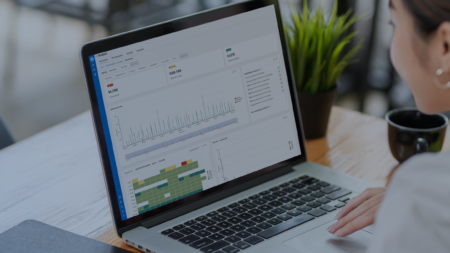Adopting AI—and understanding how this new technology can help us run our companies better—has been top of mind for most finance executives ever since ChatGPT burst onto the scene. At the same time, adoption in finance is still in progress, and for many, the search for use cases and ROI remains the priority.
Is the ROI of AI in finance just not there (yet)? We believe it very much depends!
Generative AI, or GenAI, has fueled the AI momentum—but its core design principles make it a poor match for finance:
- GenAI is non-deterministic by design, meaning the same prompt will result in a different outcome every time. This is design-specific behavior. Additionally, hallucinations—AI models making things up—introduce an additional challenge for users seeking accurate results. (Technically, this behavior is closely connected to the non-deterministic design of this technology.) Precision and repeatability are a must for any finance application.
- GenAI is not built for numerical data. It is, therefore, not a good match for tasks involving large amounts of financial data.
It’s no surprise, then, that GenAI has had only limited impact in finance to date.
High-priority use cases and tangible ROI are non-negotiable
For artificial intelligence applications to succeed in finance, the following requirements must be met:
- Quantifiable value by addressing high-priority challenges
- A measurable, attractive ROI
- Actionable results—capabilities, performance, and insights alone are not enough
- Minimal friction when integrating into existing systems, processes, and priorities
None of this is surprising. It just underlines that AI technology is not exempt from the economic realities that apply to all tool and platform purchases.
Together, unsupervised ML and generative are where AI in finance is meeting expectations today
Unsupervised machine learning, a different type of AI, is very well suited for large-scale numerical data analysis. While it has not received as much attention as LLMs, it is a deterministic technology that provides the precision, repeatability, and scalability in data analysis that most finance applications require.
Key strengths of unsupervised machine learning in finance
Data integration:
Over the past decade, we have been building data warehouses, labeling data, and applying technologies such as RPA to extract insights and actionable results from our data. This has proven to be slow, inflexible, and costly. Unsupervised machine learning works with any structured data (e.g., CRM, ERP) “as is”—no labeling or prep work required. This enables a time-to-value that is an order of magnitudes faster than previous approaches.
Scalability:
The amount of structured data in Enterprises is huge and growing rapidly. Analyzing and drawing conclusions from these vast data troves is a formidable technical challenge. For example, analyzing and detecting anomalies in millions of ledger entries at a pace that matches daily or weekly workflows is a massive technical challenge. Artificial intelligence in the form of unsupervised machine learning is the answer to this problem.
Tangible top-and bottom-line results:
It is easy to get carried away by the excitement of new technology. However, insights that do not address specific, high-priority challenges are not sufficiently valuable. At the same time, insights that cannot be actioned are not helpful and, in some cases, even harmful. Machine learning is not a “black box” technology, and it allows for the adaptation to specific problems as well as the drill-downs and specific analysis that is often required to not only identify, but also address a problem.
Where AI is delivering measurable value in finance today
Gartner is quoting in its research four areas/use cases where AI today is creating tangible value and becoming mainstream:
- Anomaly detection – e.g., transaction and balance monitoring, duplicate payment identification, payroll error identification, fraudulent or erroneous supplier invoices, etc.
- Analytics – e.g. scenario and capex planning, customer behavior analysis, predictive modeling, forecasting
- Intelligent process automation – e.g. customer credit management, invoice matching (AP), T&E optimization, cash management
- Operational assistance – e.g. intelligent dashboards, decision support, pricing automation
MindBridge has spent over a decade developing AI technology for anomaly detection in financial data. We are well prepared for this moment.
How MindBridge evolved from Big 4 validation to enterprise scale
MindBridge has been working on leveraging AI technologies, such as machine learning, to analyze financial data since 2015—long before the GenAI hype started.
At the core of our platform is anomaly detection powered by unsupervised machine learning. By risk-rating every transaction, we can identify the most serious/relevant transactions and enable an easy yet powerful drill-down. This makes it highly effective in capturing opportunities for cost reductions, revenue increases (think reduction in leakage), and fraud.
Our breakthrough came when KPMG adopted our technology as a core part of their global AI audit strategy—proof that our platform could scale to one of the world’s largest and most rigorous firms.
When the first Enterprise clients showed interest in understanding how our technology could be applied in their specific business, we jumped in headfirst…. and in the years that followed we built, in close cooperation with our customers, a product that is adapted to a successful deployment of our anomaly detection technology in an Enterprise.
Real-world results: how MindBridge clients are driving ROI
Seeing AI-powered process risk analytics working across multiple ledgers and processes is truly exciting. It not only provides transparency and insight across financial flows that have just not existed previously but also produces a convincing ROI based on:
- Top- and bottom-line improvements via the detection of inaccurate or unproved financial transactions
- Operational cost savings via the automation and de-commissioning of manual transactional controls as well as non-transactional detective controls
Our clients are identifying problems and errors in their financial flows such as the following recent examples:
- A US real estate firm identified $25.7m of purchase orders that exceeded underlying contract values
- A US consumer goods manufacturer identified $111m of delayed invoices impacting revenue recognition, and $11m in shipment/invoice mismatches
- A top 10 oil and gas provider uncovered $2.8m of vendor contract spend errors due to the application of incorrect rates
- A UK sports fashion retailer identified amended and unapproved purchase orders totaling £164k that were caught prior to payment
- A building materials merchant identified $85m in mispostings that were caught and corrected before their external audit
- A global automation software provider identified a bug that was understating closed-won opportunities between their CRM and ERP systems.
AI will undoubtedly transform the software stack we use in finance into a more powerful, autonomous, and efficient toolset. Generative AI will play a role. Machine learning will play a role. Their combination will deliver transformational applications that provide game-changing capabilities combined with a strong short—and long-term ROI to finance.
Ready to unlock hidden savings, reduce risk, and drive strategic impact with AI in finance?
Connect with our experts to see how MindBridge delivers measurable ROI through anomaly detection and machine learning—at enterprise scale.

About the author: Matthias Steinberg is CFO of MindBridge.ai, a leader in AI driven financial risk discovery. Previously he was CFO of IONOS.com, Europe’s largest mass market hosting provider where he oversaw a multi-year effort to ready the company for its IPO. In the process, he developed an interest in AI technologies to transform risk management and assurance in the Enterprise.





